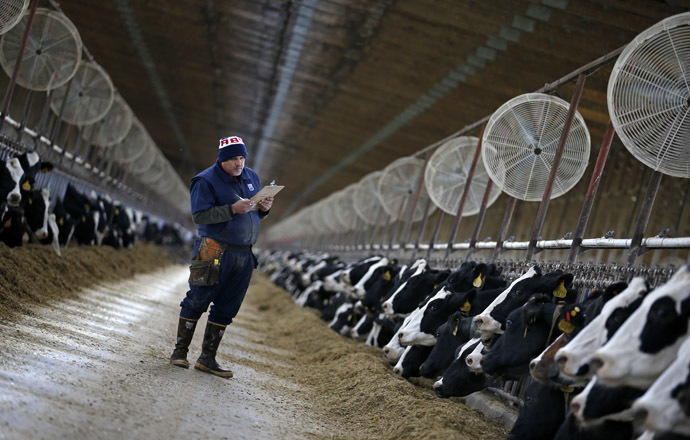Farmacology: Disease researchers say Obama’s antibiotic resistance plan should target livestock

The United States has a plan to fight the growing threat of antibiotic-resistant diseases. But some experts believe that by not focusing those that ingest most of these drugs - farm animals - humanity could face a huge problem in the future.
READ MORE: Antibiotics 'fail 15%' of patients due to superbugs and ‘reckless’ prescription
Roughly 80 percent of all antibiotics in the US are used on farm
animals, according to the Verge. With livestock consuming the
vast majority of antibiotics, the bacteria found inside the
animals gradually develop resistance against the drugs when they
are not administered in strong enough doses – meaning they also
become much harder to treat in humans if and when the bacteria
are transferred.
Earlier this month, President Barack Obama signed an executive
order establishing the steps the US would take to combat
antibiotic resistance. The order set aside $800 million in extra
funding for companies to develop new drugs, as well as $900
million for further research. The plan also prohibits farmers
from employing antibiotics on livestock for growth purposes, but
critics say it does not go nearly as far as it needs to.
"It reads as if it had been written by someone either from
the meat industry or the vet drug industry," James Johnson,
an infectious disease researcher at the University of Minnesota,
told the Verge. "The language is the standard party line
about how antibiotic use in animals makes stronger animals — that
it’s all wonderful. But that’s just one perspective, and I don’t
think it’s a science-based perspective."
Australian infectious disease researcher Lindsay Grayson told the
website that in order to fight resistance in animals more
effectively, farmers should implement new ways to manage their
livestock. Antibiotics should still be used to ensure animals
remain healthy, but the focus should be on accurately singling
out sick animals instead of applying drugs across an entire
population potentially at risk.

READ MORE: Superbug time bomb: FDA vets only 10% of antibiotics that farm animals share with humans
"No one is against using antibiotics to treat sick
animals," Grayson said, "but we shouldn’t endorse mass
preventive use on a daily basis simply because your farming
practices allow for rapid spread.”
Other experts, however, say the Obama plan is adequate,
especially since global demand for meat is likely to continue
rising and veterinarians will become more involved in the
situations on farms.
"There aren't really any loopholes," said Christine
Hoang of the American Veterinary Medicine Association. "I
don't think we should limit antibiotic use any more. It's a great
detriment to us as a profession, as well as to animal welfare, to
restrict them further."
Even if the plan doesn’t gloss over the role farm animals play in
the problem, there are other concerns being raised about the
Obama administration’s approach. Antibiotic resistance costs $21
billion each year for the American healthcare system to treat,
and resistance is believed to take the lives of 23,000 Americans
every year. The government is pumping more money into drug
development, but even an extra $800 million may not be enough to
push companies to invest – especially since developing a single
new drug costs approximately $5 billion.

Complicating the problem is the general approach of doctors to
new antibiotics, as they are often unwilling to use new drugs due
to the possibility that they may not be any better than
pre-existing drugs, or that they could trigger the beginning of a
new resistance. With that in mind, the incentive for companies to
drop billions of dollars only goes down.
It is said that antibiotics could be prescribed more efficiently
by doctors – 50 percent of people taking antibiotics do not
actually need to – but that would require better diagnostic tests
to make sure those getting the drugs can actually be helped by
them. Developing better tests means spending more money, but
compared to the hundreds of millions the government set aside for
drug development, diagnostics only received $20 million.
As the US and other countries look for ways to battle this
problem, the consequences of drug resistance are starting to get
bigger. Antibiotics are already failing to help about 15 percent
of patients due to the rise of resistant ‘superbugs’. Illnesses
like pneumonia and bronchitis, specifically, are becoming harder
to treat, with an increased antibiotics failure rate of 35
percent.














